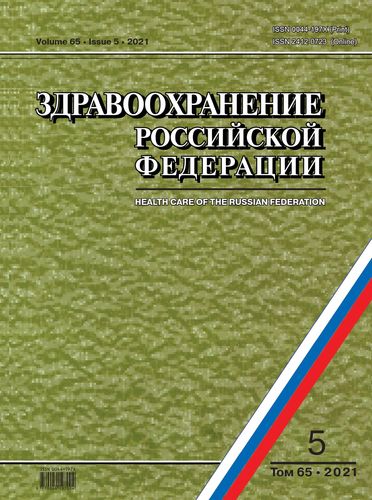The specifics of the physiological stress of the population in self-isolation due to the COVID-19 pandemic
- Authors: Polyakova O.B.1, Bonkalo T.I.2
-
Affiliations:
- Russian State Social University
- Research Institute for Healthcare Organization and Medical Management of Moscow Healthcare Department
- Issue: Vol 65, No 5 (2021)
- Pages: 432-439
- Section: PROBLEMS OF SOCIALLY SIGNIFICANT DISEASES
- Submitted: 25.10.2024
- URL: https://hum-ecol.ru/0044-197X/article/view/637976
- DOI: https://doi.org/10.47470/0044-197X-2021-65-5-432-439
- ID: 637976
Cite item
Full Text
Abstract
Introduction. The COVID-19 pandemic has forced national governments to take measures to prevent the spread of coronavirus. Self-isolation as one of the forms of protection against infection with viral diseases has led to an increase in physiological stress.
The purpose of the study is to identify the specifics of the physiological stress of the population in self-isolation due to the COVID-19 pandemic.
Material and methods. The study involved 638 students (average age — 23.38 years) undergraduate, specialist and graduate programs of full-time and part-time forms of analysis who went online during the period of self-isolation via Skype to participate in training sessions. Questionnaires were used: “What stress are you experiencing?” (P. Legeron), “Inventory of stress symptoms” (T. Ivanchenko), neuropsychic stress questionnaire (T.A. Nemchin), Toronto alexithymia scale (G.J. Taylor, D. Ryan, R.M. Bagby). Mathematical and statistical data processing — K. Pearson’s correlation criterion and Chaddock’s table.
Results. Both the average level of physiological stress (6.74) and its components with a high connection were revealed: severity, increase, duration and frequency of neuropsychic stress (0.84, 0.86, 0.76, 0.86); disturbed sleep and wakefulness (0.82); negative sensations of the activity of the cardiovascular system (0.79), respiratory organs (0.80); pain and temperature sensations (0.73 and 0.75); drop in muscle tone (0.81); physical discomfort (0.84); increased susceptibility to external stimuli (0.87); decreased physical activity (0.79).
Discussion. The results of studies by domestic and foreign doctors and psychologists confirm the need for diagnostics, prevention and correction of all types of stress conditions and levelling of physiological stress.
Conclusion. The revealed specificity of physiological stress (pain in different parts of the body, dizziness and headaches, poor sleep, stiffness of movements, difficulty in breathing, an increase in the amount of food, coffee, cigarettes, fatigue, heart palpitations and physical stress) provides a basis for the management of primary and secondary prevention of general, physiological and emotional stress with the involvement of doctors, physiologists and psychologists.
Keywords
About the authors
Olga B. Polyakova
Russian State Social University
Author for correspondence.
Email: noemail@neicon.ru
ORCID iD: 0000-0003-2581-5516
Russian Federation
Tatyana I. Bonkalo
Research Institute for Healthcare Organization and Medical Management of Moscow Healthcare Department
Email: bonkalotatyanaivanovna@yandex.ru
ORCID iD: 0000-0003-0887-4995
Doctor of Psychology, Head of the Department of the Research Institute for Healthcare Organization and Medical Management of Moscow Healthcare Department, Moscow, 115088, Russian Federation.
e-mail: bonkalotatyanaivanovna@yandex.ru
Russian FederationReferences
- Sidyacheva N.V., Zotova L.E. Situation of forced self-isolation during the pandemic: psychological and academic aspects. Sovremennye naukoemkie tekhnologii. 2020; (5): 218–25. https://doi.org/10.17513/snt.38060 (in Russian)
- Khasuev A.E. Social insulation and human self-insulation: social-philosophical analysis. Ekonomicheskie i gumanitarnye issledovaniya regionov. 2020; (2): 122–8. (in Russian)
- Lebedeva V.D. Physiological bases of stress. Vestnik nauchnykh konferentsiy. 2015; (2-1): 93–4. (in Russian)
- Akhmedova K.S. Physiological mechanisms of the effect of stress on the cardiovascular system. Vestnik Chechenskogo gosudarstvennogo universiteta. 2015; (3): 71–8. (in Russian)
- Jafar Zade D.A., Senkevich L.V., Polyakova O.B., Basimov M.M., Strelkov V.I., Tarasov M.V. Features of professional deformations (burnout) of medical workers depending on working conditions. Prensa Medica Argentina. 2019; 105(1): 1000334. https://doi.org/10.41720032-745X.1000334
- Balvochyus M., Mashichev A.S. Problems of physical culture in conditions of self-isolation. Molodoy uchenyy. 2020; (21): 230–2. (in Russian)
- Mil’ko M.M., Guremina N.V. Students physical activity investigation in conditions of distance learning and self-isolation. Sovremennye naukoemkie tekhnologii. 2020; (5): 195–200. https://doi.org/10.17513/snt.38056 (in Russian)
- Boncalo T.I., Polyakova O.B. Emotional exhaust as a factor of the origin and development of neurotic conditions of medical workers. Problemy sotsial’noy gigieny, zdravookhraneniya i istorii meditsiny. 2020; 28: 1208–14. https://doi.org/10.32687/0869-866X-2020-28-s2-1208-1214 (in Russian)
- Bonkalo T.I., Polyakova O.B., Bonkalo S.V., Kolesnik N.T., Sorokoumova E.A. Development of ethnic social identity among the members of ethnic community organizations as the factor of preventing the spread of nationalist sentiments in a multicultural society. Biosci. Biotech. Res. Asia. 2015; 12(3): 2361–72. https://doi.org/10.13005/bbra/1912
- Farakhov A.F. Self isolation as the factor of loneliness. Nauka Krasnoyar’ya. 2013; 2(2): 74–81. (in Russian)
- Elshansky S.P., Anufriev A.F., Polyakova O.B., Semenov D.V. Positive personal qualities and depression. Prensa Medica Argentina. 2018; 104(6): 1000322. https://doi.org/10.41720032-745X.1000322
- Elshansky S.P., Anufriev A.F., Polyakova O.B., Semenov D.V. Positive personal qualities and depression. Prensa Medica Argentina. 2019; 105(8): 461–8. https://doi.org/10.41720032-745X.1000322
- Polyakova O.B., Petrova E.A., Mironova O.I., Semenov D.V. Specificity of рsychosomatization of psychologist-leaders with professional deformations (burnout). Prensa Medica Argentina. 2019; 105(1): 1–7. https://doi.org/10.41720032-745X.1000326
- Polyakova O.B., Boncalo T.I. Features of psychosomatization of medical personnel with occupational deformities. Problemy sotsial’noy gigieny, zdravookhraneniya i istorii meditsiny. 2020; 28(S2): 1195–201. https://doi.org/10.32687/0869-866X-2020-28-s2-1195-1201
- Polyakova O.B., Bonkalo T.I. Features of psychosomatization of medical professionals with occupational deformations. Zdravookhranenie Rossiyskoy Federatsii. 2020; 64(5): 278–86. https://doi.org/10.46563/0044-197X-2020-64-5-278-286 (in Russian)
- Sokolovskaya I.E., Polyakova O.B., Romanova A.V., Belyakova N.V., Tereshchuk K.S. Educational and professional motivation of students with various religious. Eur. J. Sci. Theol. 2020; 16(4): 169–80.
- Kovaleva A.A., Skedina M.A., Potapov M.G. Neurophysiological state of humans in long-duration isolation. Aviakosmicheskaya i ekologicheskaya meditsina. 2016; 50(4): 14–20. https://doi.org/10.21687/0233-528X-2016-50-4-14-20 (in Russian)
- Polyakova O.B. General Psychological Workshop. Part 3. Emotional-Volitional Processes: Collection of Diagnostic Procedures [Obshchiy psikhologicheskiy praktikum. Chast’ 3. Emotsional’no-volevye protsessy: Sbornik diagnosticheskikh protsedur]. Moscow; 2011. (in Russian)
- Vodop’yanova N.E. Psychodiagnostics of Stress [Psikhodiagnostika stressa]. St. Petersburg: Piter; 2009. (in Russian)
- Nemchin T.A. Questionnaire of neuropsychiatric stress. Available at: https://medlec.org/lek3-157256.html (in Russian)
- Esin R.G., Gorobets E.A., Galiullin K.R., Esin O.R. Alexithymia – baseline trends of research. Zhurnal nevrologii i psikhiatrii im. S.S. Korsakova. 2014; 114(12): 148–51. https://doi.org/10.17116/jnevro2014114121148-151 (in Russian)
Supplementary files










